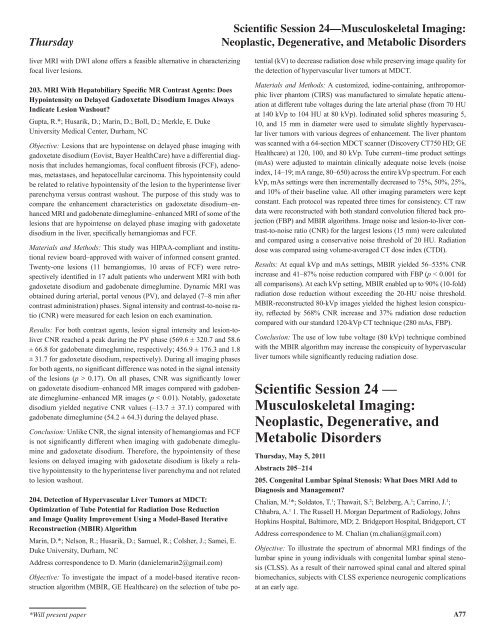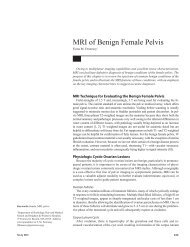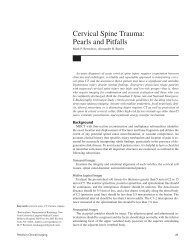<strong>Scientific</strong> <strong>Session</strong> 23—Gastrointestinal <strong>Imaging</strong>:Liver <strong>Imaging</strong>—Focal Disease and TechniqueThursdaytion contrast-enhanced liver MDCT and gadoxetate disodium-enhancedliver MRI were included. The sequence protocol consisted of a dynamic3D gradient-recalled echo T1-weighted dataset (triple arterial, portal venous,late dynamic, and hepatocyte-phase images). Three independentreaders reported the presence of hepatic arterial (HA), portal venous(PV), and hepatic venous (HV) vascular variants. Reader’s confidencewas measured using a 5-point scale (1 = excellent, 2 = good, 3 = fair,4 = poor, 5 = none) and the preferred dynamic contrast phase were alsonoted. Sensitivities and specificities for the detection of vascular variantswere calculated with contrast-enhanced high-resolution CT images servingas the reference standard for hepatic vascular anatomy.Results: HA variants, PV variants, and HV variants were present in 12, 7,and 14 patients, respectively. Mean sensitivity and specificity were 69.5%(range, 66.7–75.0%) and 96.3% (range, 92.6–100%) for HA variants,85.7% (range, 57.1–100%) and 93.8% (range, 87.5–100%) for PV variants,and 75.6% (range, 64.3–92.9%) and 89.3% (range, 76–100%) for HVvariants. Diagnostic confidence was higher for PV anatomy (mean, 1.5)than for HA and HV anatomy (both 1.8). Overall, the preferred sequencewas the triple arterial phase for assessing HA anatomy, the portal venousphase for PV anatomy, and hepatocyte-phase images for HV anatomy.Conclusion: The sensitivity of gadoxetate disodium–enhanced MR imagesfor the detection of hepatic arterial variants is markedly inferior tocontrast-enhanced MDCT, which may preclude its use as a “one-stopshop” modality before liver resection.201. Intrapatient Variation of Late Arterial Phase Contrast-Enhanced Liver CT Scans Obtained With Fixed Versus Patient-Specific Scan DelaysCabarrus, M.*; Wong, K.; Fu, Y.; Varenika, V.; Yee, J.; Yeh, B.University of California, San Francisco, San Francisco, CAAddress correspondence to B. Yeh (ben.yeh@radiology.ucsf.edu)Objective: To examine intrapatient variation in scan delay for late arterialphase liver CT scans and compare scan quality when fixed versus timingbolus-determinedpatient specific scan delays are used.Materials and Methods: We retrospectively identified 137 patients whoeach underwent four multiphase liver CT scans, two obtained with a fixed45-second scan delay and two with patient-specific delays determinedby a timing bolus. The scans were rated as too early, optimal, or too latebased on whether the portal vein was poorly opacified, the portal veinwas well opacified, or the hepatic vein was opacified, respectively. Weused pancreatic parenchyma as a surrogate for hypervascular lesions tomeasure conspicuity against liver parenchyma (HU).Results: Patient-specific scan delays resulted in a higher frequency of optimallate arterial phase scans (246 of 274 scans, or 89.8%) and greaterpancreas-to-liver conspicuity (68 HU) than fixed delay (181 of 274 scans,or 66.1%, p < 0.01; 57 HU, p < 0.01). For paired patient-specific scandelayCTs, the intrapatient scan delay between optimal scans differed bymore than 6 seconds in 29 of 115 patients (25%), and the mean differencein scan delays for all paired optimal scans was 4 seconds (range, 0–30 seconds).Optimal studies showed greater pancreas-to-liver conspicuity thanthose graded too early or too late (65.5 HU vs 50.2 HU and 39.9 HU, p= 0.047, p < 0.01, respectively). For fixed delay scans classified as early,optimal, and late, the mean corresponding scan delays as determined bysubsequent patient specific scans were progressively shorter: 48.5, 46.6,and 44.8 seconds, respectively (p < 0.05 for each comparison to optimal).Conclusion: Scan-to-scan variations in patient circulation physiology arecommon, substantial, and should be considered to obtain optimal latearterial phase CT scans. Compared with fixed delay, individualized liverCT scan delays more consistently obtained high quality late arterial phaseimages, which are critical for lesion detection.202. Comparison of Accuracy of MRI With Diffusion-Weighted<strong>Imaging</strong> Versus MRI With Dynamic Contrast Enhancement inCharacterizing Focal Liver LesionsTappouni, R. 1 ; El Khady, R. 2 ; Sarwani, N. 1 *; Dykes, T. 1 1. Penn StateHershey Medical Center, Hershey, PA; 2. Assiut University, Assiut, EgyptAddress correspondence to R. Tappouni (raftappouni@gmail.com)Objective: To compare the accuracy of diffusion-weighted imaging (DWI)with that of dynamic contrast enhancement (DCE) and that of DWI andDCE in characterizing benign versus malignant liver lesions during liverMRI and to compare the accuracy of DWI with that of DCE and with thatof DWI and DCE in the correct diagnosis of liver lesions during liver MRI.Materials and Methods: Sixty-six adult patients with focal liver lesions wereincluded in this retrospective institutional review board–approved study.One hundred fifteen lesions that were greater than 1 cm in diameter andclearly seen on the DWI and apparent diffusion coefficient map were selectedby one of the investigators. Two radiologists with more than 5 years’MRI experience independently gave each lesion a confidence score for differentiatingbenign from malignant lesions and for final diagnosis. Duringthe first session, each reader was given standard unenhanced MR sequenceswith DWI only. After 4 weeks, readers were asked to characterize the lesionsagain using unenhanced and DCE sequences without DWI and a finalcharacterization using standard sequences with DCE and DWI. The finalpathologic diagnosis was reached by biopsy or with imaging follow-up.Results: For reader 1, sensitivity, specificity, and accuracy of differentiatingbenign from malignant lesions using unenhanced MRI with DWIwere 95.8%, 86.6%, and 90.4%; using DCE MRI alone were 87.5%,94.0%, and 91.3%; and using DCE MRI with DWI were 100%, 97%,and 98.3%. For reader 2, sensitivity, specificity, and accuracy for differentiatingbenign from malignant lesions using unenhanced MRI withDWI were 91.7%, 89.6%, and 90.4%; using DCE MRI were 85.4%,94.0%, and 90.4%; and using DCE MRI with DWI were 95.8%, 95.5%,and 95.7%. The accuracy for making final diagnosis for unenhancedMRI with DWI, MRI with DCE, and DCE MRI with DWI were 83.5%,87%, and 93.9% for reader 1 and 80%, 84.4%, and 91.3% for reader 2.Combining the accuracy of both readers, DCE MRI combined with DWIwas 3.3 times more accurate than DWI and DCE alone in differentiatingbenign from malignant liver lesions. DCE MRI with DWI was 2.8 timesmore accurate than DWI alone, and twice as accurate as DCE alone, inenabling correct diagnosis of a focal liver lesion.Conclusion: MRI with DWI alone and MRI with DCE alone have similaraccuracy for characterizing focal liver lesions. MRI with DCE and DWIcombined has increased accuracy compared with either DWI or DCEalone. In patients with contraindication to gadolinium contrast material,A76*Will present paper
Thursday<strong>Scientific</strong> <strong>Session</strong> 24—Musculoskeletal <strong>Imaging</strong>:Neoplastic, Degenerative, and Metabolic Disordersliver MRI with DWI alone offers a feasible alternative in characterizingfocal liver lesions.203. MRI With Hepatobiliary Specific MR Contrast Agents: DoesHypointensity on Delayed Gadoxetate Disodium Images AlwaysIndicate Lesion Washout?Gupta, R.*; Husarik, D.; Marin, D.; Boll, D.; Merkle, E. DukeUniversity Medical Center, Durham, NCObjective: Lesions that are hypointense on delayed phase imaging withgadoxetate disodium (Eovist, Bayer HealthCare) have a differential diagnosisthat includes hemangiomas, focal confluent fibrosis (FCF), adenomas,metastases, and hepatocellular carcinoma. This hypointensity couldbe related to relative hypointensity of the lesion to the hyperintense liverparenchyma versus contrast washout. The purpose of this study was tocompare the enhancement characteristics on gadoxetate disodium–enhancedMRI and gadobenate dimeglumine–enhanced MRI of some of thelesions that are hypointense on delayed phase imaging with gadoxetatedisodium in the liver, specifically hemangiomas and FCF.Materials and Methods: This study was HIPAA-compliant and institutionalreview board–approved with waiver of informed consent granted.Twenty-one lesions (11 hemangiomas, 10 areas of FCF) were retrospectivelyidentified in 17 adult patients who underwent MRI with bothgadoxetate disodium and gadobenate dimeglumine. Dynamic MRI wasobtained during arterial, portal venous (PV), and delayed (7–8 min aftercontrast administration) phases. Signal intensity and contrast-to-noise ratio(CNR) were measured for each lesion on each examination.Results: For both contrast agents, lesion signal intensity and lesion-toliverCNR reached a peak during the PV phase (569.6 ± 320.7 and 58.6± 66.8 for gadobenate dimeglumine, respectively; 456.9 ± 176.3 and 1.8± 31.7 for gadoxetate disodium, respectively). During all imaging phasesfor both agents, no significant difference was noted in the signal intensityof the lesions (p > 0.17). On all phases, CNR was significantly loweron gadoxetate disodium–enhanced MR images compared with gadobenatedimeglumine–enhanced MR images (p < 0.01). Notably, gadoxetatedisodium yielded negative CNR values (–13.7 ± 37.1) compared withgadobenate dimeglumine (54.2 ± 64.3) during the delayed phase.Conclusion: Unlike CNR, the signal intensity of hemangiomas and FCFis not significantly different when imaging with gadobenate dimeglumineand gadoxetate disodium. Therefore, the hypointensity of theselesions on delayed imaging with gadoxetate disodium is likely a relativehypointensity to the hyperintense liver parenchyma and not relatedto lesion washout.204. Detection of Hypervascular Liver Tumors at MDCT:Optimization of Tube Potential for Radiation Dose Reductionand Image Quality Improvement Using a Model-Based IterativeReconstruction (MBIR) AlgorithmMarin, D.*; Nelson, R.; Husarik, D.; Samuel, R.; Colsher, J.; Samei, E.Duke University, Durham, NCAddress correspondence to D. Marin (danielemarin2@gmail.com)Objective: To investigate the impact of a model-based iterative reconstructionalgorithm (MBIR, GE Healthcare) on the selection of tube potential(kV) to decrease radiation dose while preserving image quality forthe detection of hypervascular liver tumors at MDCT.Materials and Methods: A customized, iodine-containing, anthropomorphicliver phantom (CIRS) was manufactured to simulate hepatic attenuationat different tube voltages during the late arterial phase (from 70 HUat 140 kVp to 104 HU at 80 kVp). Iodinated solid spheres measuring 5,10, and 15 mm in diameter were used to simulate slightly hypervascularliver tumors with various degrees of enhancement. The liver phantomwas scanned with a 64-section MDCT scanner (Discovery CT750 HD; GEHealthcare) at 120, 100, and 80 kVp. Tube current-time product settings(mAs) were adjusted to maintain clinically adequate noise levels (noiseindex, 14–19; mA range, 80–650) across the entire kVp spectrum. For eachkVp, mAs settings were then incrementally decreased to 75%, 50%, 25%,and 10% of their baseline value. All other imaging parameters were keptconstant. Each protocol was repeated three times for consistency. CT rawdata were reconstructed with both standard convolution filtered back projection(FBP) and MBIR algorithms. Image noise and lesion-to-liver contrast-to-noiseratio (CNR) for the largest lesions (15 mm) were calculatedand compared using a conservative noise threshold of 20 HU. Radiationdose was compared using volume-averaged CT dose index (CTDI).Results: At equal kVp and mAs settings, MBIR yielded 56–535% CNRincrease and 41–87% noise reduction compared with FBP (p < 0.001 forall comparisons). At each kVp setting, MBIR enabled up to 90% (10-fold)radiation dose reduction without exceeding the 20-HU noise threshold.MBIR-reconstructed 80-kVp images yielded the highest lesion conspicuity,reflected by 568% CNR increase and 37% radiation dose reductioncompared with our standard 120-kVp CT technique (280 mAs, FBP).Conclusion: The use of low tube voltage (80 kVp) technique combinedwith the MBIR algorithm may increase the conspicuity of hypervascularliver tumors while significantly reducing radiation dose.<strong>Scientific</strong> <strong>Session</strong> 24 —Musculoskeletal <strong>Imaging</strong>:Neoplastic, Degenerative, andMetabolic DisordersThursday, May 5, 2011Abstracts 205-214205. Congenital Lumbar Spinal Stenosis: What Does MRI Add toDiagnosis and Management?Chalian, M. 1 *; Soldatos, T. 1 ; Thawait, S. 2 ; Belzberg, A. 1 ; Carrino, J. 1 ;Chhabra, A. 1 1. The Russell H. Morgan Department of Radiology, JohnsHopkins Hospital, Baltimore, MD; 2. Bridgeport Hospital, Bridgeport, CTAddress correspondence to M. Chalian (m.chalian@gmail.com)Objective: To illustrate the spectrum of abnormal MRI findings of thelumbar spine in young individuals with congenital lumbar spinal stenosis(CLSS). As a result of their narrowed spinal canal and altered spinalbiomechanics, subjects with CLSS experience neurogenic complicationsat an early age.*Will present paperA77
















